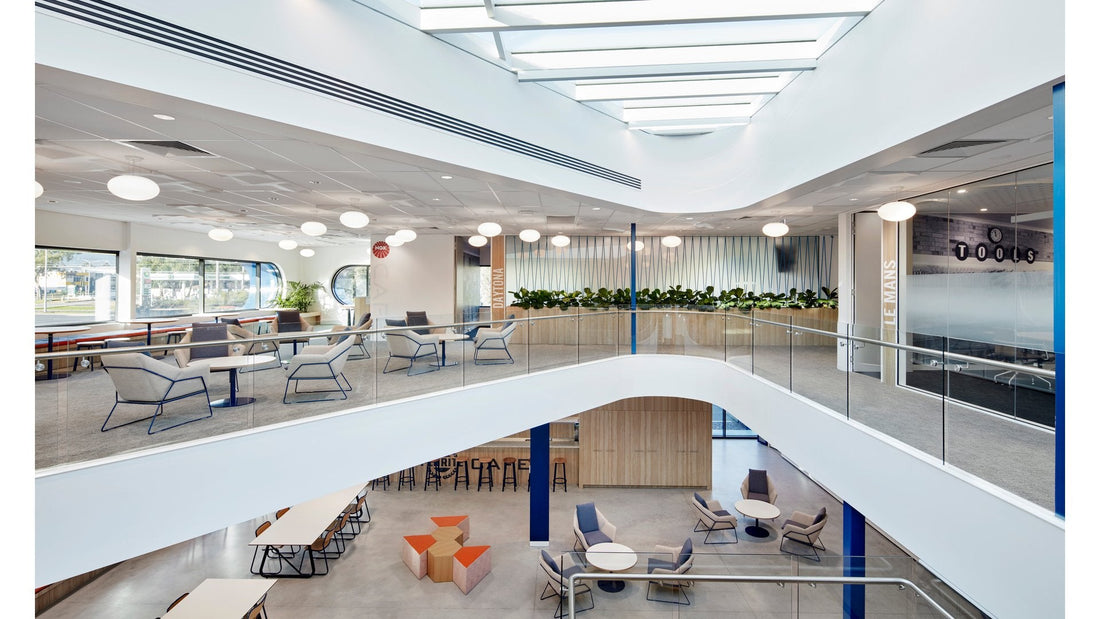
Lighting for Wellbeing in the Workplace – Designing Spaces That Boost Productivity and Health
Share
In today’s fast-paced, digitally driven world, the workplace is more than a desk and a chair—it’s an environment that directly affects wellbeing and performance. Among the most powerful design elements shaping that environment is lighting. Poor lighting contributes to fatigue, headaches, and reduced concentration, while great lighting fosters productivity, comfort, and creativity.
As businesses recognize that employee wellbeing is central to success, workplace lighting design is evolving. It is no longer about simply providing enough brightness; it’s about designing light for people.
The Science of Light and Productivity
Lighting directly impacts the body’s natural rhythms. Our circadian rhythm, or internal clock, regulates alertness and sleepiness based on light exposure.
- Bright, cool light (4000K–5000K) in the morning increases alertness and focus.
- Warmer, dimmer light (2700K–3000K) in the afternoon and evening promotes relaxation and helps prepare the body for rest.
In an office setting, exposure to the wrong type of light at the wrong time can leave employees feeling drained or restless. Conversely, lighting aligned with natural rhythms enhances energy, focus, and overall wellbeing.
Research has shown that workplaces with human-centric lighting systems report improved productivity, reduced absenteeism, and higher employee satisfaction.

Natural Light as the Best Light
Daylight is the gold standard of workplace lighting. It not only reduces energy consumption but also positively affects mood and health.
Benefits of natural light:
- Enhances vitamin D levels.
- Improves sleep quality.
- Increases productivity and morale.
Design strategies for daylighting:
- Maximize window placement and size.
- Use light shelves and reflective surfaces to bring daylight deeper indoors.
- Position workstations to benefit from access to natural light while minimizing glare.
Daylight harvesting systems, which adjust artificial lighting based on available daylight, create an efficient and comfortable balance.
Human-Centric Lighting in Offices
When natural light isn’t enough, human-centric lighting fills the gap. These systems mimic daylight patterns, supporting circadian rhythms.
Key features:
- Tunable white LEDs: Change color temperature throughout the day.
- Dynamic controls: Automatically shift brightness and tone to match natural rhythms.
- Personal control: Allow employees to adjust light at their desks for comfort.
These solutions improve focus during working hours while promoting relaxation in collaborative or break spaces.

Design Techniques for Different Zones
Lighting should match the function of each workplace zone.
Workstations:
- Bright, glare-free task lighting.
- Indirect fixtures to minimize eye strain.
- Adjustable task lamps for personal control.
Meeting Rooms:
- Flexible systems with dimming.
- Cooler tones for presentations, warmer tones for brainstorming sessions.
Break Areas:
- Warm, inviting light that signals rest.
- Accent lighting to create a hospitality-inspired atmosphere.
Circulation Areas:
- Balanced brightness for safety.
- Subtle accent lighting to guide flow without distraction.

Sustainability Meets Wellbeing
Sustainable lighting and wellbeing go hand in hand. LED systems, sensors, and smart controls reduce energy consumption while creating healthier spaces.
- Energy-efficient LEDs lower costs and carbon footprints.
- Occupancy sensors prevent wasted energy in empty rooms.
- Daylight integration ensures artificial light is used only when needed.
Designing for sustainability ensures workplaces are both responsible and restorative.
Case Studies & Examples
Case Study 1 – Corporate Office Redesign:
A global tech firm implemented tunable lighting across its campus. Employees reported better focus in the morning and improved relaxation in creative sessions, leading to measurable gains in productivity.
Case Study 2 – Co-working Space:
A co-working hub integrated daylight harvesting and dimmable LED pendants. The result: a 40% reduction in energy use and a warmer, more inviting atmosphere that attracted freelancers and startups.
Common Mistakes to Avoid
- Over-reliance on overhead lighting: Creates glare and fatigue.
- Ignoring personal control: Employees benefit from adjusting light levels to their needs.
- Static lighting systems: Fixed color temperature and brightness don’t support natural rhythms.
- Designing without flexibility: Workplaces change; lighting should adapt with them.
Conclusion – Light as a Workplace Asset
Lighting is no longer a background feature—it’s a tool that directly influences performance and wellbeing. By designing offices with a balance of natural light, human-centric systems, and flexible controls, businesses create healthier, happier, and more productive environments.
The workplace of the future isn’t just efficient—it’s illuminated with people in mind.
At Lighting Design Online, we specialize in workplace lighting solutions that enhance wellbeing, improve productivity, and save energy. Contact us today to reimagine your office lighting design.
